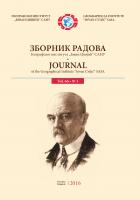Can Border Municipalities Count On Education As A Resource Development?
Can Border Municipalities Count On Education As A Resource Development?
Author(s): Marija Anđelković StoilkovićSubject(s): Culture and social structure , Adult Education, Social development, Rural and urban sociology, Present Times (2010 - today), Human Resources in Economy, Sociology of Education
Published by: Географски институт »Јован Цвијић« САНУ
Keywords: education; literacy; educational attainment; human resources; border municipalities;
Summary/Abstract: Education is one of the relevant topics, when it comes to the development of a society. There aren’t economic and cultural progresses without educated and skilled workforce. In terms of ageing, “lifelong learning” is introduced as a new perspective in the field of education. There are large regional disparities in the educational structure of the population of Serbia. In this paper, research will include the educational characteristics of the population of Serbian border municipalities, primarily working-age population. The importance of monitoring the educational structure is large, having in mind the indicators of development. The aim of the paper is to determine the availability and quality of human resources. The typology of the border municipalities was done according to achieved level of education of the population. In addition to the basic indicators, literacy and educational attainment, education was monitored through the share of the population with lower educational achievements and tertiary education in specific age groups. The analysis is based on the Census 2011, with a comparison of the two-preceding censuses. The results show that border municipalities have lower educational attainment than the average of Serbia, with great inter-municipal and regional differences, and differences in education by sex, age and type of settlement. The municipalities with larger urban centers have better educational achievements, but the high share of the population with primary education in the population of smaller municipalities cause to doubt of whether these border municipalities can count on education as a development resource.
Journal: Зборник радова Географског института "Јован Цвијић" САНУ
- Issue Year: 66/2016
- Issue No: 3
- Page Range: 433-448
- Page Count: 16
- Language: English

